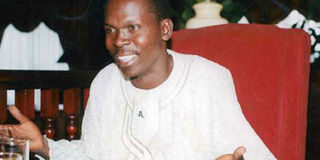Tales of pain and survival in Daniel Moi torture cells

Former student leader Wafula Buke recounts his dark ordeal at the Nyayo House torture chambers during Daniel Moi's regime. PHOTO | FILE | NATION MEDIA GROUP
What you need to know:
- The cubicles, with firm steel doors, served as waterlogged cells. Except for a small opening on the walls, which provided some ventilation.
- Odinga recalls an enraged officer Rono breaking off the leg of a wooden table and slamming it repeatedly on his head and shoulders.
Wilfully provoking police officers so that they can brutalise you to a point of unconsciousness is odd and appalling.
Yet this is a deliberate ploy that worked well for Wafula Buke, a survivor of the infamous Nyayo House torture chambers.
“The trick was to taunt them into a bloody confrontation. If they turned down the invitation, you unleashed a savage blow to the face of one of the officers. This was enough provocation to earn you a direct ticket to some hospital and comfort,” recounts Mr Buke with a chuckle.
The brutality visited on victims, mainly accused of undermining the government of President Daniel arap Moi in the 1980s, was unbearable and stretched for days, weeks and months on end, Mr Buke said.
The best way out of this torture was to scheme for one’s way to hospital. There, one got medical attention, a bed and better food.
The University of Nairobi student leader only learnt of this trick much later, after becoming a frequent “guest” at the government torture chambers in the basement of Nyayo House, along Nairobi’s Kenyatta Avenue.
MEDICAL ATTENTION
When he was first arrested in November 1987, as leader of Students’ Organisation of Nairobi University (Sonu), he was clobbered senseless for 14 straight days and subjected to all manner of torture, including being stripped naked and locked in a waterlogged cell.
When he returned for a second time, a couple of years later, following his arrest for belonging to the February Eighteenth Resistance Army (Fera), a Ugandan-based dissident group alleged to have been plotting to topple Moi, Mr Buke was wiser.
“This time round I was hostile to the police because I wanted us to engage in violence immediately, so that I get clobbered quickly. The trick worked. And when I regained consciousness, I was in a hospital bed,” he recalled.
Mr Buke is among scores of Kenyans who, during Moi’s 24-year rule, were subjected to physical torture at the Nyayo House basement for their suspected role in undermining or plotting to topple the Moi regime.
And following Moi’s death last week, Kenyans have portrayed the country’s second president variously -- as a loving and well-meaning leader, or one who ruled the country with an iron fist.
DISCIPLINING DISSIDENTS
Either way, the torture chambers of Nyayo House remain one of the darkest spots in Moi’s rule.
According to Koigi wa Wamwere, another survivor of the torture chambers, the underground of Nyayo House had several basement cubicles separated by one long corridor.
The cubicles, with firm steel doors, served as waterlogged cells. Except for a small opening on the walls, which provided some ventilation, the rooms were dark and there was no way of knowing whether it was day or night.
“This must have been deliberate with the motive of inducing sleep among the detainees so that they can sleep and probably drown in the water,” said Mr Wamwere, who later fled to Norway.
Mr Wamwere was, however, re-arrested in Busia, along the Kenya-Uganda border as he tried to sneak back into the country.
He was beaten up, left unconscious and only woke up a day later completely naked and immersed in water at the Nyayo House basement.
Here, he was subjected to the old routine of endless physical torture.
INHUMANE OFFICERS
To minimise the pain and effects of the torture, Mr Buke said he would stand knock-kneed to cover his testicles and wrap his hands around his torso to shield his ribs from baton whips.
In his autobiography, The Flame of Freedom, ODM leader Raila Odinga speaks of his experience of torture following his arrest over his role in the aborted 1982 coup.
The former prime minister details the torture meted out by an officer of the then Special Branch named Josiah Kipkurui Rono and his team, who were determined to extract a confession from him on the coup attempt.
He recalls an enraged Rono breaking off the leg of a wooden table and slamming it repeatedly on his head and shoulders.
“The blows to my head dazed me and I fell to the floor. And, as I lay there, Rono and the others jumped on my chest and my genitals”.
Besides Rono, the names of one James Opiyo and Leonard Wachira remain on the lips of Nyayo House torture victims. Buke recalls “the small bodied Wachira” breaking his tooth with a pistol strike.
MENTAL TORTURE
But the pain was not limited to physical torture. Mr Wamwere said living like amphibians was tough: “We had long and short calls in the same water, which we also drank when thirsty.”
But the biggest torture for Mr Wamwere was psychological. From his cell he would hear screams and his torturers would tell him that they were from his mother, which was a lie. They threatened to kill her if he did not open up.
Mr Odinga, too, recalled how, after being denied food for several days, Police Commissioner Ben Gethi came in person to interrogate him chewing away on a mouth-watering roasted goat leg.
“They tried that on me (food denial) and I lost my voice. They had no option but to put something in my system, so that they can try to extract what they wanted,” said Mr Buke.




